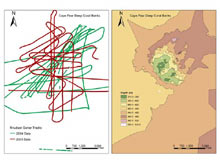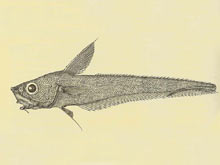
The drawing (on top) of Nezumia sclerorhynchus (roughtip grenadier) was from a paper by Marshall in 1973 and has served as a standard illustration of this species for many years. Compare this to a specimen photographed in life during our cruises (on bottom). Besides data on coloration, otherwise unavailable, such views give data on habitat, swimming behavior, and orientation. Click image for larger view and image credit.
Filling In The Gaps
October 30, 2005
Dr. Steve W. Ross
Lead PI & Chief Scientist
University of North Carolina at Wilmington (currently on assignment to
US Geological Survey)
The degree to which the deep-sea fauna is known covers a wide range, with some species being relatively well studied and others being very poorly documented. In most cases, however, the data we have on these deep-sea animals were derived from gear deployed from ships far above the bottom. This indirect sampling usually produced specimens that arrived on deck in very poor condition. The changes in temperature and pressure, the rough treatment from some gear (like trawls), coupled with the fragile nature of most deep-sea animals doomed many collections to be poor representatives of their ecosystems. On top of this, scientists studying the taxonomy or biology of these specimens may only see their subjects long after they are collected, after they had spent months, even years, in a preservative that further changed the appearances of the animals from their conditions in life. This aspect of deep-sea biology represents a huge difference compared to shallow water biology where greater proportions of the fauna have been observed in their native habitats.
Besides addressing the major objectives of our project, the methods we employ (particularly the submersible) allow us to contribute a variety of miscellaneous pieces of data that have been otherwise unattainable. Often the animals we observe, even ones that are well known, are being recorded by our cameras and scientists for the first time. Some species may have been described in the taxonomic literature and their general distributions documented over a hundred years ago, yet their living colorations, their behaviors (how they swim, feed, or reproduce), their interactions with habitats (burrowing in sediments, hiding under rocks, hovering over the bottom, etc.), and interactions with each other are unknown, and we are recording them for the first time.
Indirect sampling usually produces specimens that arrive on deck in very poor condition. The changes in temperature and pressure, the rough treatment from some gear (like trawls), coupled with the fragile nature of most deep-sea animals (see above a toxic sea urchin) doom many collections to be poor representatives of their ecosystems. Click image for larger view and image credit.

Two years of ship tracks plotted over the Cape Fear deep coral bank area off North Carolina, illustrating dense coverage of single beam sonar (left panel). Using those data allowed a plot of depth zones in detail. Click image for larger view and image credit.
It is amazing how little direct observation data we have for the deep ocean (below SCUBA depth), and the deeper we go the more acute this problem becomes. Our work provides several examples of how direct observations allow a more complete, accurate view of the deep sea. For instance, taxonomic descriptions of fishes known as rat tails (a large, widely distributed group), especially in the genus Nezumia , often include some coloration descriptions that do not match what we see on the bottom. We have found that colorations of the first dorsal fin are distinctive (see photo), yet the literature may not help us identify these fishes by sight. In fact, the literature may add to our confusion. Therefore, we use the submersible to film these fishes, then we collect a specimen, and because of the protected collection containers, the specimen is returned to the surface in very good condition. There, it is again photographed as soon as possible before it is preserved. Because we have video footage (and/or high quality still photos) along with the actual specimen, we can now be reasonably certain how to identify this species in the rest of our huge archive of video tapes and in future dives. Most of these "voucher" specimens are eventually deposited in major museum collections (such as The Smithsonian Institution or the NC Museum of Natural Sciences), facilitating even greater usage. It seems like a small thing, but this is a unique and highly valuable function of using a manned submersible. Such contributions are "bonus" data that we collect as we focus on the project's major objectives.
We fill in data gaps in other ways. The best way to map the bottom in detail is to use multibeam sonar, a type of sonar that uses many overlapping beams to obtain bottom depth and other details. But this tool is not readily available. Nevertheless, we still have access to high quality depth soundings that are recorded to the computers. Before each dive we conduct a survey of our study areas with as many overlapping tracks as time allows. These data, plus similar data for the area from past years, are combined in a computer mapping program that gives us increasingly more detail about the bottom, both for sites we have sampled for several years and new sites (see maps). In addition to their current roles in helping guide our bottom sampling and understanding the structure of bottom features, these data will guide future multibeam mapping.
There are many examples of the variety of data flowing into this project. In some cases it may even be months or years before we discover through analysis of samples that we have made a significant discovery. We do focus our major attentions on the primary objectives we were funded to address. However, our goal at all times is to take advantage of these unique opportunities to contribute information on deep sea ecosystems.
Please check back frequently for more logs as the expedition unfolds.
Sign up for the Ocean Explorer E-mail Update List.



























